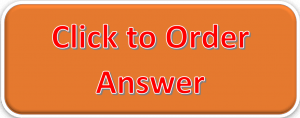Written Assignment for HUMS 201 – (MUST READ) Emotional Intelligence by Daniel Goleman
Written Assignment for HUMS 201 – (MUST READ) Emotional Intelligence by Daniel Goleman
The goal of the project is to have you read and understand the information contained in the book, Emotional Intelligence. One of the keystone skills in interacting with people is emotional intelligence. The ability to understand and manipulate the emotions of others begins with the ability to understand and manipulate the emotions of ourselves.The paper is to be 6-7 pages in length, double spaced, utilizing Times New Roman font at 11 points. You will have a title page that does not count toward the 6-7 pages and you will number the pages in the top right corner starting after the title page. You will have a bibliography page with at least one reference on it, Emotional Intelligence. You can add more if you have additional references. Please double check your work to avoid spelling, grammatical and punctuation errors. You may want to supplement the information from the book with other sources, make sure to reference those sources and make sure they are valid.
Written Assignment for HUMS 201 – Emotional Intelligence by Daniel Goleman – Due 12/4/2020
The goal of the project is to have you read and understand the information contained in the book, Emotional Intelligence. One of the keystone skills in interacting with people is emotional intelligence. The ability to understand and manipulate the emotions of others begins with the ability to understand and manipulate the emotions of ourselves. Emotional intelligence and the related skills can not only help you be a more effective counselor or case manage but also improve the quality of your personal relationships. And to a large extent, the quality of one’s life is directly tied to the quality of one’s relationships.
Please answer the following questions in your paper:
- Define the construct of traditional human Intelligence and the method of Intelligence testing and compare it to emotional intelligence. Give both the technical definition of emotional intelligence and how you would describe it your grandfather.
- Summarize chapter one. Explain what are emotions for and explain the function of emotions?
- Salovey and Mayer (1990) outline five domains of emotional intelligence: Knowing one’s emotions, managing emotions, motivating oneself, recognizing emotions in others and handling relationships. Provide a definition of each of the five domains and one real world example of each.
- Provide a summary of chapter 6, The Master Aptitude. Include the following information from the chapter: the Marshmallow test, Pandoras box, Pollyanna/optimism and Flow.
- Provide a summary of chapter nine, Intimate Enemies.Include Freuds definition of a fully mature adult, summarize Brody and Halls research on differences in emotions between the sexes, explain Dr, Gottman’s work with couples and how toxic arguing can lead to emotional hijacking.
- Provide definitions of what Dr, Gottman called the four horsemen of the apocalypse related to toxic arguing; criticism, contempt, defensiveness and stonewalling. Give real world examples of each.
- Give a brief example of how a Medical Doctor with high emotional intelligence would be a more effective Doctor than one with low emotional intelligence.
The paper is to be 6-7 pages in length, double spaced, utilizing Times New Roman font at 11 points. You will have a title page that does not count toward the 6-7 pages and you will number the pages in the top right corner starting after the title page. You will have a bibliography page with at least one reference on it, Emotional Intelligence. You can add more if you have additional references. Please double check your work to avoid spelling, grammatical and punctuation errors. You may want to supplement the information from the book with other sources, make sure to reference those sources and make sure they are valid.
Contact me with questions, concerns or minor panic attacks. 
Professor Cesare
Written Assignment for HUMS 201 – (MUST READ) Emotional Intelligence by Daniel Goleman Read More »
